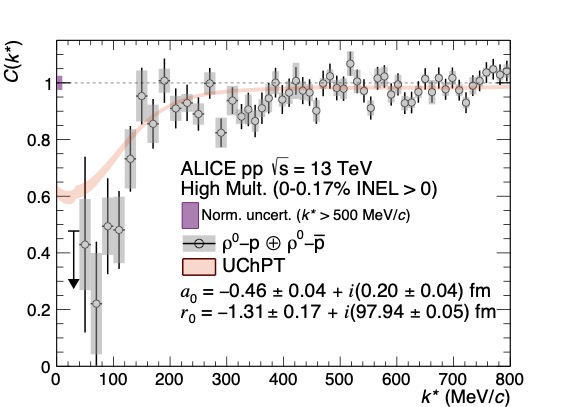
Article in CERN Courier Nov/Dec 2025
Link to CERN Courier Nov/Dec 2025 magazine
The ALICE collaboration recently obtained the first direct measurement of the attraction between a proton and a ρ0 meson – a particle of particular interest due to its fleeting lifetime and close link to chiral symmetry breaking. The result establishes a technique known as femtoscopy as a new method for studying interactions between vector mesons and baryons, and opens the door to a systematic exploration of how short-lived hadrons behave.
Traditionally, interactions between baryons and vector mesons have been studied indirectly at low-energy facilities, using decay patterns or photoproduction measurements. These were mostly interpreted through vector–meson–dominance models developed in the 1960s, in which photons fluctuate into vector mesons to interact with hadrons. While powerful, these methods provide only partial information and cannot capture the full dynamics of the interaction. Direct measurements have long been out of reach, mainly because the extremely short lifetime of vector mesons – of the order of 1–10 fm/c – renders conventional scattering experiments impossible.
At the hadronic level, the strong force can be described as arising from the exchange of massive mesons, with the lightest among them, the pion, setting the interaction range to about 1.4 fm. For such a short-range effect to influence the products of a pp collision, the particles must be created close together and with low relative momentum, ensuring sufficient interaction time and a significant wavefunction overlap.
The ALICE collaboration has now studied this mechanism in high-multiplicity proton–proton (pp) collisions, at a centre-of-mass energy of 13 TeV, through femtoscopy, which examines correlations in the relative momentum (k*) of particle pairs in their rest frame. These were expected to carry information on the size and shape of the particle-emitting source at k* below about 200 MeV, with any deviations from unity indicating the presence of short-ranged forces.
To study the interaction between protons and ρ0 vector mesons, candidates were reconstructed via the hadronic decay channel ρ0 → π+π–, identified from π+π– pairs within the 0.70–0.85 GeV invariant mass window. Since the ρ0 decays almost instantly into pions, only about 3% of the candidates were genuine ρ0 mesons. Background corrections were therefore essential to extract the ρ0–proton correlation function, defined as the ratio of the relative-momentum distribution of same-event pairs to that of mixed-event pairs. The result is consistent with unity at large relative momenta (k* > 200 MeV), as expected in the absence of strong forces. At lower values, however, a suppression with significance of about four standard deviations clearly signals ρ0–proton final-state interactions (see figure).

Figure: The measured ρ0–proton correlation in high-multiplicity pp collisions. The suppression of ρ0–proton pairs at low relative momenta indicates an attractive interaction consistent with theoretical predictions.
To interpret these results, ALICE used an effective field model based on chiral perturbation theory, which predicted two resonance states consistent with the formation of excited nucleon states. Because some pairs linger in these quasi-bound states instead of flying out freely, fewer emerge with nearly the same momentum. This results in a correlation suppression at low k* consistent with observations. Unlike photoproduction experiments and QCD sum rules, femtoscopy delivers the complete phase information of the ρ0–proton interaction. By analysing both ρ–proton and φ–proton pairs, ALICE extracted precise scattering parameters that can now be incorporated into theoretical models.
This measurement sets a benchmark for vector-meson–dominance models and establishes femtoscopy as a tool to probe interactions involving the shortest-lived hadrons, while providing essential input for understanding ρ–nucleon interactions in vacuum and describing the meson’s properties in heavy-ion collisions. Pinning down how the ρ meson behaves is crucial for interpreting dilepton spectra and the restoration of chiral symmetry, as differences between light quark masses become negligible at high energies. For example, the mass gap between the ρ and its axial counterpart, a1, comes from spontaneous chiral-symmetry breaking.
